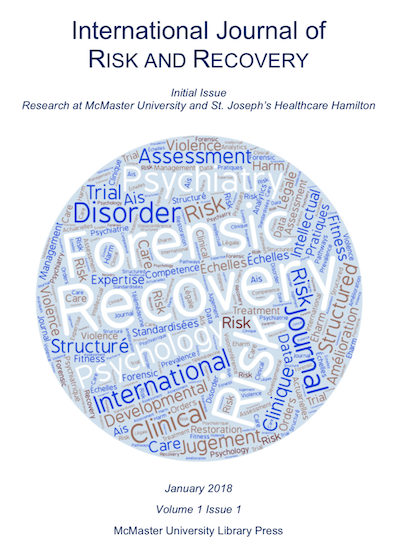HARM and AIS as risk assessment tools in forensic psychiatry
Benefits and limitations of their use in France
DOI:
https://doi.org/10.15173/ijrr.v1i1.3405Abstract
In this letter, the authors review briefly the concept of risk assessment in psychiatry. They provide some knowledge about the use of the Hamilton Anatomy of Risk Management (HARM) and Aggressive Incidents Scale (AIS), as risk assessment and management tools. They look at the limitations and benefits of using these scale in France. (article in French)
References
Monahan J, Skeem JL. The evolution of violence risk assessment. CNS Spectrums 2014;19(5): 419-24
Voyer M, Senon JL. Présentation comparative des outils d’évaluation du risque de violence. InfPsychiatr2012;88(6):445-53
Hanson RK, Harris AJR. Where should we intervene? Dynamic predictors of sexual offense recidivism. Crim Justice Behav2000;27(1):6-35
Cook AN, Moulden HM, Mamak M, Lalani S, Messina K, Chaimowitz G. Validating the Hamilton Anatomy of Risk Management–Forensic Version and the Aggressive Incidents Scale. Assessment 2016 in press
Vanderstukken O, Lacambre M. Dangerosité, prédictivité et échelles actuarielles : confusion ou détournement ? InfPsychiatr201;87(7):549-50
Published
How to Cite
Issue
Section
License
Copyright Notice
Authors who publish with this journal agree to the following terms:
- Authors retain copyright of their work and grant the International Journal of Risk and Recovery the right of first publication with the work simultaneously licensed under a Creative Commons Attribution License. This allows others to share the work with an acknowledgement of the work’s authorship and initial publication in this journal.
- Authors are able to enter into separate, additional contractual arrangements for the non-exclusive distribution of the journal’s published version of the work (e.g., post it to an institutional repository or publish it in a book) with an acknowledgement of its initial publication in this journal.
- Authors are permitted and encouraged to post their work online (e.g., in institutional repositories or on their websites) before and during the submission process as it can lead to productive exchanges, as well as earlier and greater citation of published work. (See The Effect of Open Access.)

